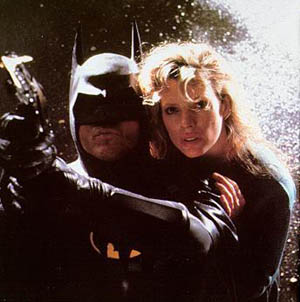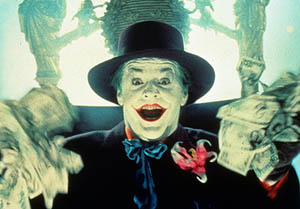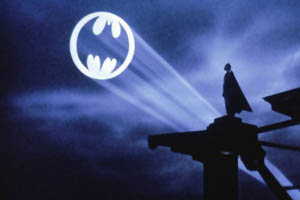|
I remember when Tim Burton's first Batman film came out, all those years ago. Being that I was fully sentient at the time, how could I possibly have forgotten? No film that I have heard of before or since has been prefaced with such an overwhelming deluge of merchandising hype as this one. For unending months ahead of time, one could not move so much as four or five angstroms without seeing that black and yellow bat logo plastered upon whatever the powers that were could find to plaster it upon: lunchboxes, towels, propylactics, random piles of dog droppings; it was enough to make you want to burn every print of the film before you even saw it, just to send a message to the ad wizards of the world about staying the hell out of your face. But the film finally came out, and the hype didn't stop. Erik Preminger of San Francisco's KGO-TV effusively referred to it as "the movie of the decade." I've often wondered if, in the subsequent years, he's ever regretted and wished to rescind that wholly ridiculous proclamation, bestowed as it was upon a film that, despite being iconic and surprising to audiences of its day, was a rather weak storytelling vehicle. 
The criminals of Gotham City are scared. Reports of a "bat-man" knocking off lawbreakers has the underworld in a tizzy, as none of them know what a "bat-man" really is. Is he just some nut in a costume, or a blood-drinking monster? In a notable early scene, a pair of purse-snatchers find out the hard way that Batman isn't just a scare story when he descends upon them and thrashes the hell out of them in much the way one might expect to see a slasher movie villain assail his oblivious stock teen victims; this choice to introduce Batman through the eyes of his prey is an interesting one. The film then swiftly moves to show the character through the eyes of some more ancilliary characters, which is almost instantly less interesting. Enquirer-esque reporter Knox introduces himself to photographer Vicky Vale by referring to his gigantic shlong for no discernable reason, and the pair plot to ambush the local government bigwigs at Bruce Wayne's upcoming shindig, just to get the inside scoop on the mysterious "batman" situation. We then meet Commissioner Gordon and DA Harvey Dent, which would be a shift in the right direction if the film had bothered to actually use these characters for anything other than window dressing for the fanboys. All of the scenes of discovery that should have been seen through the eyes of these Batman mainstays get handed off to the much less interesting Vale and Knox. Wayne himself finally arrives in the form of the unassuming and quite effective Michael Keaton, a choice considered odd at the time but which paid off nicely, aside from the utter upstaging the character would suffer at the hands of the villain of the piece. 
When you name your film "Batman," one goes in with a certain expectation regarding the focus of said film. It was, then, somewhat frustrating to see just how much the film really should've been named "The Joker." Yes, Jack Nicholson is more flamboyant, but the film itself caters to his character far more than it needs to. Avoiding a detailed origin story for Batman was an interesting idea. However, concocting an origin for the Joker veritably forces the film to be slanted the wrong way, as it cannot help but to follow more closely the character with an actual story arc. Sociopathic mob underling Jack Napier gets set up by his boss, who has learned of Jack's affair with the boss's main squeeze. Busted by Batman (following a sequence edited so choppily that I'm still not quite sure what happened or why), Jack falls into a vat of chemicals and is left for dead, only to emerge from a drainpipe with bleached skin, green hair, a permanent smile, and a far more hyperactive and ebullient personality. What the hell kind of chemical combo does all that but somehow doesn't just poison you to death? Don't ask. It's a comic book movie. Actually, it apparently does poison some people to death, just not Jack. Corpses start turning up with frozen Joker grins; the Joker has started sneaking his concoction into various products so as to create random havoc. While it's the sort of thing the Joker would do, and it affords the film the chance to showcase the oft-unused detective side of Batman, it isn't remotely cinematic. For all I know, the plot killed thousands of Gotham's citizens, but without the camera taking us on a guided tour of their homes and offices, there's no way to register the threat. This film is, in no sense whatsoever, concerned with logic. It's an ode to art design, a series of set pieces that don't build so much as just happen sequentially, a chance to hear Kim Basinger scream forty billion times. It's not concerned with making sense, and not just nit-picky shit like the contents of the Joker's chem bath. The animated sheilds that protect the Batmobile have to pop on from offscreen just so you can't tell that they're coming from absolutely nowhere. How does the Joker manage to take over TV broadcasts whenever he feels like it? Where, as the Joker himself famously asked, does Batman get all those wonderful toys? He shows up for the final battle in an armed jet fighter, blasting missiles and machine guns into a crowded street. A privately-owned jet fighter. Where the hell is the Air Force when this sort of shit goes down? For that matter, how does the Joker, a man suspected of mass murder (and who, in his ultimately exposed former identity as Jack Napier, was already facing arrest), get to hold a huge parade in the middle of town without being jumped by the entire police force? Oh, right: comic book movie. 
Batman did boast some cool noir stylings, and was doubtlessly a refreshing change for the majority of filmgoers who only knew Batman via the old Adam West TV show. In spite of some initial trepidation on my part, I thought Michael Keaton brought something human and honest to the role, showing Wayne as a driven but essentially decent man with a need to right hopeless wrongs. But if one ever needed proof that two hours of scenes laid out in a row do not automatically constitute a plot, they need look no further. -review by Matt Murray
|
|
||||||||